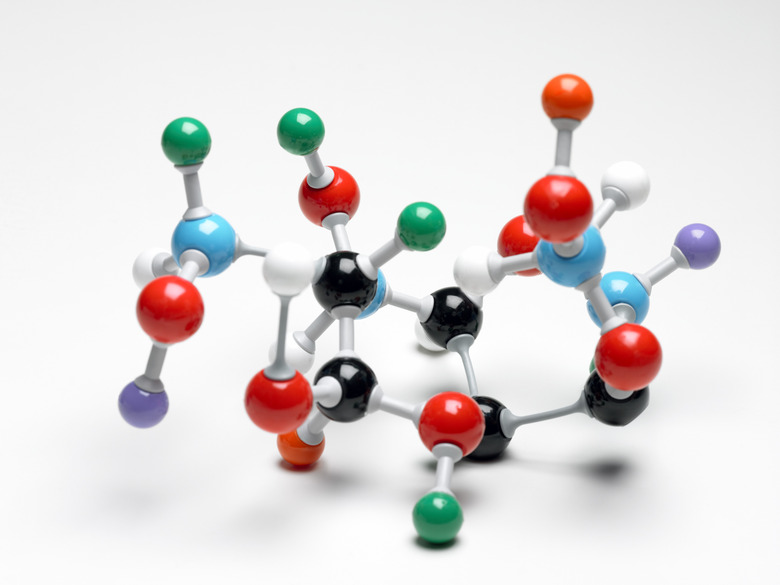What Are An Atom, Electron, Neutron And Proton?
The atom, derived from a Greek word that translates loosely into "that which cannot be divided," is widely considered to the the fundamental unit of all matter. Atoms consist of subatomic particles called protons, neutrons and electrons, with the former two residing in the nucleus of the atom and accounting for almost all of its mass, and electrons confined to orbitals on the edge of the atom. The number of protons in naturally occurring atoms ranges from 1 to 92; these different atoms correspond to elements, which have different electrochemical properties owing to their varying masses and the unique arrangement of their tiny constituent particles in space.
The Proton
The Proton
The proton is, in effect, the index particle of any atom. It is the number of protons in an atom that determines the identity of the element an atom belongs to; in other words, if two atoms have a different number of protons, they are not the same element.
The number of protons in an element determines its atomic number, Z. Hydrogen is the lightest element and has one proton (Z = 1); uranium is the heaviest naturally occurring element and has 92 protons (Z = 92). Each proton, which is assigned a mass of 1.00728 atomic mass units (amu), has a charge designated as +1.
Atoms can exist with only a proton in their nucleus, as is the case with hydrogen atoms. A nucleus without at least one accompanying proton, however, is not an atom.
The Neutron
Neutrons are similar in size to protons, with an amu of 1.00867, and also inhabit the nucleus of atoms. The number of neutrons in an atom in an element's most stable configuration is usually greater than the number of protons, with this disparity becoming larger as atomic number increases. A hydrogen atom, for example, has a proton but no neutrons, while a helium atom has two of each. Tin, on the other hand, has 50 protons and 69 neutrons, while uranium has 92 and 146 respectively.
The number of protons plus neutrons in an atom is its mass number, M. Thus the number of neutrons in an atom is its atomic mass number minus its atomic number, or M – Z.
If an atom gains or loses neutrons, it remains the same element but becomes an isotope of that element. Different isotopes are identified by appending M to the upper left corner of the abbreviation for that element. For example, 14C is an isotope of carbon (Z = 6) that has eight neutrons rather than the usual six.
The Electron
Electrons are tiny (0.000549 amu), negatively charged particles that are described as orbiting the protons and neutrons that make up an atom's nucleus, in the manner of planets orbiting the sun. This is a rough description at best, however, as advances in quantum physics have led to the concept of discrete orbitals about the nucleus between which electrons may "jump." These orbitals correspond to different electromagnetic energy levels and are given names such as s, p, d and f. The motion of electrons stems from their having a charge of -1 and being attracted to the positively charged nucleus.
Normally, the number of electrons in an atom is equal to Z, making these atoms neutral in overall charge. Some atoms have different numbers of protons and electrons, resulting in a net positive or negative charge. These atoms are called ions.
The Atom
Atoms are extremely small particles and cannot be divided further except by extraordinary means. Think of the pieces that make up a jigsaw puzzle. These can technically be separated into smaller pieces of cardboard and paper by destroying them, but for practical purposes, these pieces are the fundamental, indivisible elements of jigsaw puzzles.
Atoms consist of protons, which carry a positive electrical charge; electrons, which carry a negative charge; and neutrons, which carry no charge. Thus in an ordinary, electrically neutral atom, the number of protons and the number of electrons is equal.
The atomic mass of an atom is approximately equal to the number of protons plus the number of electrons, since the mass of electrons is practically negligible.
Cite This Article
MLA
Beck, Kevin. "What Are An Atom, Electron, Neutron And Proton?" sciencing.com, https://www.sciencing.com/atom-electron-neutron-proton-7777671/. 19 May 2018.
APA
Beck, Kevin. (2018, May 19). What Are An Atom, Electron, Neutron And Proton?. sciencing.com. Retrieved from https://www.sciencing.com/atom-electron-neutron-proton-7777671/
Chicago
Beck, Kevin. What Are An Atom, Electron, Neutron And Proton? last modified August 30, 2022. https://www.sciencing.com/atom-electron-neutron-proton-7777671/
